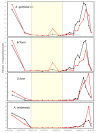The contribution of aestivating mosquitoes to the persistence of Anopheles gambiae in the Sahel
- PMID: 21645385
- PMCID: PMC3123247
- DOI: 10.1186/1475-2875-10-151
The contribution of aestivating mosquitoes to the persistence of Anopheles gambiae in the Sahel
Abstract
Background: Persistence of African anophelines throughout the long dry season (4-8 months) when no surface waters are available remains one of the enduring mysteries of medical entomology. Recent studies demonstrated that aestivation (summer diapause) is one mechanism that allows the African malaria mosquito, Anopheles gambiae, to persist in the Sahel. However, migration from distant localities - where reproduction continues year-round - might also be involved.
Methods: To assess the contribution of aestivating adults to the buildup of populations in the subsequent wet season, two villages subjected to weekly pyrethrum sprays throughout the dry season were compared with two nearby villages, which were only monitored. If aestivating adults are the main source of the subsequent wet-season population, then the subsequent wet-season density in the treated villages will be lower than in the control villages. Moreover, since virtually only M-form An. gambiae are found during the dry season, the reduction should be specific to the M form, whereas no such difference is predicted for S-form An. gambiae or Anopheles arabiensis. On the other hand, if migrants arriving with the first rain are the main source, no differences between treated and control villages are expected across all members of the An. gambiae complex.
Results: The wet-season density of the M form in treated villages was 30% lower than that in the control (P < 10-4, permutation test), whereas no significant differences were detected in the S form or An. arabiensis.
Conclusions: These results support the hypothesis that the M form persist in the arid Sahel primarily by aestivation, whereas the S form and An. arabiensis rely on migration from distant locations. Implications for malaria control are discussed.
Figures




References
-
- della Torre A, Tu Z, Petrarca V. On the distribution and genetic differentiation of Anopheles gambiae s.s. molecular forms. Insect Biochem Mol Biol. 2000;35:755–769. - PubMed
-
- Fontenille D, Lochouarn L, Diagne N, Sokhna C, Lemasson JJ, Diatta M, Konate L, Faye F, Rogier C, Trape JF. High annual and seasonal variations in malaria transmission by anophelines and vector species composition in Dielmo, a holoendemic area in Senegal. Am J Trop Med Hyg. 1999;56:247–253. - PubMed
-
- Toure YT, Petrarca V, Traore SF, Coulibaly A, Maiga HM, Sankare O, Sow M, Di Deco MA, Coluzzi M. Ecological genetic studies in the chromosomal form Mopti of Anopheles gambiae s.s. in Mali, West Africa. Genetica. 1999;94:213–223. - PubMed
-
- Toure YT, Petrarca V, Traore SF, Coulibaly A, Maiga HM, Sankare O, Sow M, Di Deco MA, Coluzzi M. The distribution and inversion polymorphism of chromosomally recognized taxa of the Anopheles gambiae complex in Mali, West Africa. Parassitologia. 1999;40:477–511. - PubMed
-
- Donnelly MJ, Simard F, Lehmann T. Evolutionary studies of malaria vectors. Trends Parasitol. 2000;18:75–80. - PubMed
Publication types
MeSH terms
Grants and funding
LinkOut - more resources
Full Text Sources

